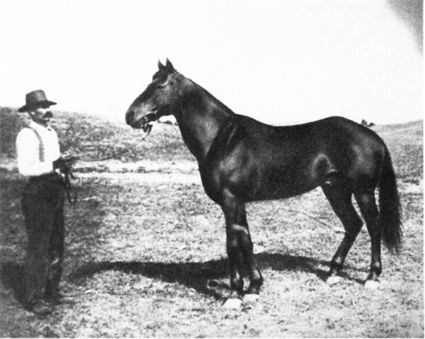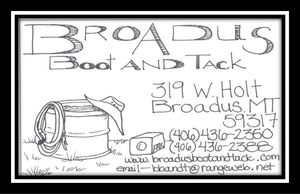What Really Happened To George Mitchell?
July 23, 2020

George Mitchell and his thoroughbred horse "Diamond Dick," circa 1907. This photo is purported to be by LA Huffman (but not confirmed).
The fourth and final article in a series, written by Historian Shane Dunning. Shane may be reached at [email protected].
George Mitchell was, by even the accounts of his friends, an argumentative and possessive man. That being said, he was also well-known cattle and horseman in his community, devoted to his large family. He did not like sheep and believed that Link Wilson's ovine interests were a serious threat to his livestock's water and his livelihood. According to John Daut, Mitchell had a gentleman's agreement with the local sheep magnate Robert R. Selway regarding delineations of range that the elder Selway honored for several years. However, R.R. Selway moved to Sheridan in 1900 and placed his Pumpkin Creek operation in the control of his brother Delos. Delos was not considered as strong as his brother, and I speculate that Link Wilson, Selway's longtime partner in sheep operations, did not honor this pre-existing agreement in the same manner as Bob Selway. This caused the boisterous Mitchell to run his mouth, possibly to the extreme of the death threats testified to. How serious these threats were considered is a matter of debate. It should be stressed that Wilson was not legally bound by this agreement, and that Wilson was at the time transitioning to an expanded cattle operation. By any measure, however, the enmity between the two factions was well established as the month of September began.
The UA Roundup was run by Woodley and Tarbell but was a sanctioned event. Even the contradicting testimony at the trials revealed that Tarbell specifically prevented members of the Mitchell family from working George's cattle. Several head of Mitchell's cattle were in the herd that day, and George Mitchell had more than enough reason and standing to collect his own cattle. If Tarbell seriously felt Mitchell was such a danger, he seemingly had plenty of alternatives available to prevent George Mitchell's physical presence at the roundup. Specifically, he could have allowed Scott Mitchell, George's nephew, who had worked the roundup for at least a week, to cut out his uncle's cattle. Indeed, Scott testified that he was willing to do so but was prevented by Tarbell.
Perhaps the most compelling evidence of George Mitchell's lack of deadly intention that day was the fact that he came to the roundup unarmed. If the elder Mitchell had come to the roundup with some intent other than gathering his own cattle at a roundup being run by his enemies, he was about to poke a grizzly bear with a very short stick. Given his long-established history of being a successful trail boss for the Newman Brothers' N Bar outfit, it is difficult to believe that Mitchell was given to such recklessness.
The testimony establishes that Tarbell, along with Woodley, Eubanks and several others, brought in the last bunch of cattle that day shortly before the incident. When they did so, they observed the Mitchell party and moved aggressively to confront them. According to his own testimony, Tarbell sent Woodley ahead to find out Mitchell's "intentions." Given Mitchell's threatening statements, an action of this type seems reasonable. What is not reasonable, however, is sending Woodley to make this determination when several obviously less provocative alternatives were immediately available. The whole theory of the defense was predicated on the serious threats Mitchell had supposedly directed specifically toward Tarbell and Woodley. Sending Woodley, of all the available people, to determine Mitchell's intentions was a provocative act and undercuts the defense theory of the case.
That being said, several (but not all) witnesses indicate that Jackson fired the first shot. The fact that both Jackson and Ray Mitchell had come to the roundup armed two days in a row is also revealing. It displays a level of tension that could naturally result in a gunfight. George Mitchell took the specific action to get Jackson's gun and turn for home, telling his son "let's get out of here."
By all accounts Jackson's gun was in Mitchell's left hand when he turned around to face Tarbell. He and his son Ray did so because Tarbell had hailed them, supposedly with the infamous line "Hold on, I don't want to have to shoot you in the back." Tarbell, in his testimony, only states that the Mitchells suddenly turned back toward the herd without giving a reason. The specificity of Ray Mitchell's testimony on this aspect is much more compelling and is somewhat supported by the testimony of others who heard Tarbell call to Mitchell before he turned around (although only Jackson would confirm the quote).
As they faced each other for this final confrontation, an important question must be answered. Did Tarbell have a reasonable belief that Mitchell's fire was imminent and required his own action? Only one of these men had experience killing a man in self-defense at a shootout. In 1903, Ray Tarbell had killed a man in Bridgeport, Nebraska, during an argument and was cleared by the coroner's jury. Even if this Nebraska incident was a legitimate case of self-defense, it also demonstrates Tarbell's quick reflexes and coolness under fire.
It seems to be reasonable for Tarbell to have believed, perhaps only at that very moment, that George Mitchell posed a deadly threat. The fact that Tarbell himself had likely provoked Mitchell to such a state may be despicable, but it nonetheless was reasonable for him to defend himself. Considering the social cost of being considered a coward in the American West at the time, it seems likely to me that both men fired at the same time.
The days following the killing would prove vital to Ray Tarbell's future. He surrendered himself to the Sheriff and was bailed out by Link Wilson. Tarbell was able to obtain the services of the best lawyer in Eastern Montana, former judge Charles H. Loud. The defense team clearly knew their client was going to trial, and therefore were not aggressive at the preliminary hearing. At that hearing, they gained the advantage to getting the state's witnesses on the record, while ever-so-gently laying the groundwork for self-defense. In doing so, however, they allowed the state's narrative to be repeated all through Powder River country with little contradiction.
With much of the state's case now on the record, the defense then transformed George Mitchell's aggressive verbosity into the rabid threats of a dangerous man. Suddenly, almost a dozen eyewitnesses not used by the state in the preliminary hearing became available to testify for Ray Tarbell's claim of self-defense. Putting the victim on trial, Loud and his partner Campbell lined up a dozen men (some prominent cattlemen) to say Mitchell was belligerent and quarrelsome. Tarbell's own cattleman bone fides were used to quell anti-sheep sentiment and make Mitchell's ire seem unhinged. Until the trial transcript is found, we can never know how (or if) the state considered whether Mitchell's threats (if they even happened) may have had the effect of angering Tarbell and Woodley, rather than scaring them. The newspaper accounts give no reason to think the prosecution did so.
Indeed, there is some testimony that Tarbell and Woodley anticipated tragedy would occur that day. A.F. Kelly testified that Tarbell had told him days before the shooting that he (Tarbell) would shoot Mitchell if he "showed his head up over the hill," meaning if he came near the roundup. This testimony was severely colored by Kelly's admission (under cross-examination) that he had consumed "half a skin full" before taking the stand. This clashes with the near unanimous testimony that Tarbell and Woodley were unarmed throughout the roundup until day after Ray Mitchell and Jackson came to the roundup with their pistols. In a sense, the armed presence of Mitchell and Jackson the day before can also be considered a somewhat provocative act. It apparently caused Tarbell and his associates to arm themselves for a fight they showed virtually no interest in avoiding.
Hindsight being 20/20, it is clear that EVERY party to this tragic affair had multiple opportunities to avoid the tragedy that ensued, and that almost none did. The remarks of the trial judge, Sidney Sanner, seem to come to a similar conclusion when he pinned the tragedy on the common practice of carrying guns. Perhaps what would be most unfair would be to judge all the participants in this incident with the values of our present day. From today's perspective, we can too easily blame the common practice of carrying guns and the social norms of not backing down from a fight. While that may be true, we have had the advantage of over one hundred years learning from all-too numerous tragedies such as this. Sheep spoiling a water hole for cattle today would not deprive ten children of a father and a wife of her husband, and for that we can perhaps be thankful.





Reader Comments(0)